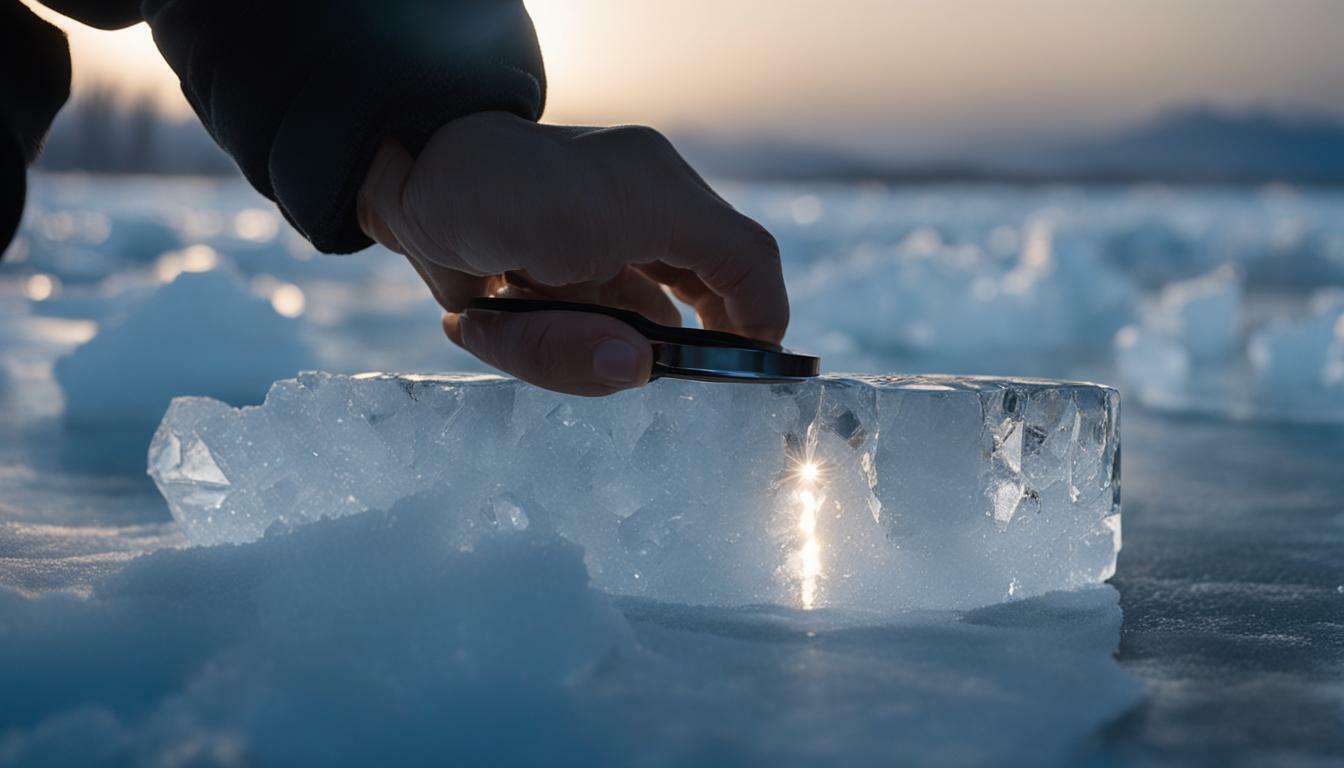Are you curious to know if your crystals are real? Learn how to test their authenticity using the ice test method. In order to test if crystals are real with ice, there are several factors to consider. Real natural crystals are cool to the touch, don’t scratch easily, contain imperfections, and are usually heavier than fake crystals. Synthetic and heat-treated crystals can still be used for healing, meditation, or manifesting. Some signs that a crystal may be fake include feeling suspiciously light, feeling warm to the touch, having bright and saturated colors, having tiny air bubbles inside, looking too clear and perfect, shattering or scratching easily, smoking, smelling or melting when exposed to flame, having unusual or overly descriptive names, having a low price for a quality crystal, and the seller having little knowledge about their crystals. It’s important to be cautious of unknowledgeable sellers and to do research on reputable retailers before purchasing crystals.
Key Takeaways:
- Real crystals are cool to the touch, don’t scratch easily, contain imperfections, and are usually heavier.
- Synthetic and heat-treated crystals can still be used for healing, meditation, or manifesting.
- Signs of fake crystals include feeling suspiciously light, feeling warm to the touch, having bright and saturated colors, having tiny air bubbles inside, looking too clear and perfect, shattering or scratching easily, smoking, smelling or melting when exposed to flame, having unusual or overly descriptive names, having a low price for a quality crystal, and sellers with little knowledge about their crystals.
- Be cautious of unknowledgeable sellers and do research on reputable retailers before purchasing crystals.
Factors to Consider When Testing Crystals with Ice
When using the ice test to determine the authenticity of crystals, there are several factors to consider. Real natural crystals exhibit certain characteristics that can help distinguish them from fake ones. These factors include:
- Coolness to the touch: Real crystals tend to feel cool when touched. This is because crystals have the ability to conduct heat and draw energy from their surroundings.
- Resistance to scratching: Genuine crystals are durable and resistant to scratching. If a crystal easily gets scratched by a sharp object, it may be an indication that it is not real.
- Imperfections: Real crystals often have imperfections such as small cracks, uneven surfaces, or inclusions. These imperfections are a natural part of the crystal’s formation and are not present in synthetic or fake crystals.
- Weight: Most real crystals are heavier than their fake counterparts. If a crystal feels unusually light in comparison to its size, it may be a sign that it is not genuine.
By observing these factors, you can begin to identify and distinguish real crystals from fake ones. It’s important to note that the ice test is just one method used to verify crystal authenticity, and it should be used in conjunction with other tests and observations to make a definitive determination.
Adding an H3 Heading If Relevant
In some cases, additional factors may also be relevant when testing crystals with ice. For example, some crystals may have specific behaviors when exposed to cold temperatures. Observing any changes in the crystal’s appearance or texture when placed on ice can provide further insight into its authenticity.
Remember, mastering the art of testing crystals with ice requires practice and experience. As you become more familiar with the characteristics of real crystals, you’ll become better equipped to identify and appreciate the genuine ones in your collection.
| Factors to Consider When Testing Crystals with Ice |
|---|
| Coolness to the touch |
| Resistance to scratching |
| Imperfections |
| Weight |
Signs of Fake Crystals to Look Out For
It’s essential to be aware of signs that a crystal may be fake when conducting the ice test at home. Fake crystals can often mimic the appearance of real ones, but there are certain indicators that can help you distinguish between the two. Here are some signs to watch out for:
- Feeling suspiciously light: Real crystals are usually heavier than fake ones.
- Feeling warm to the touch: Fake crystals may feel warmer than natural ones.
- Bright and saturated colors: Fake crystals often have colors that are too vivid or intense.
- Tiny air bubbles inside: Real crystals may have imperfections, while fake ones tend to be flawless.
- Looking too clear and perfect: Natural crystals may have inclusions or irregularities.
- Shattering or scratching easily: Fake crystals are more prone to damage.
- Smoking, smelling, or melting when exposed to flame: Real crystals are unlikely to exhibit these reactions.
Always be cautious of unusual or overly descriptive names, low prices for quality crystals, and sellers who have little knowledge about their products. These can be red flags indicating the authenticity of the crystals being sold. It’s important to do your research and purchase from reputable retailers to ensure you are getting genuine crystals.
Table: Characteristics of Real and Fake Crystals
| Characteristic | Real Crystals | Fake Crystals |
|---|---|---|
| Coolness to the touch | Yes | No |
| Resistance to scratching | Strong | Weaker |
| Imperfections | Present | Minimal or absent |
| Weight | Heavier | Lighter |
By being aware of these signs and conducting the ice test, you can determine the authenticity of crystals in your own collection. Remember to always trust your intuition and seek guidance from knowledgeable sources to ensure you are working with genuine crystals that align with your intentions.
Synthetic and Heat-Treated Crystals
Not all crystals are natural, but even synthetic and heat-treated crystals can have their own uses and benefits. While natural crystals are formed in the Earth’s crust over millions of years, synthetic crystals are created in a laboratory using various chemical processes. These synthetic crystals have the same chemical composition as their natural counterparts but are made in a controlled environment. On the other hand, heat-treated crystals undergo a process where they are exposed to high temperatures to enhance their color or clarity.
Despite not being natural, synthetic and heat-treated crystals can still be used for healing, meditation, or manifesting intentions. They possess their own unique energies and can be programmed to align with specific purposes. For example, synthetic quartz crystals are often used for amplifying intentions, while heat-treated amethyst can be used for enhancing spiritual connection.
When using the ice test to determine crystal authenticity, it’s important to note that synthetic and heat-treated crystals may exhibit different characteristics compared to natural ones. For instance, synthetic crystals may not feel as cool to the touch as natural crystals since they have a different molecular structure. Heat-treated crystals may also have altered physical properties due to the high-temperature treatment.
| Signs of Synthetic and Heat-Treated Crystals | How to Identify Them |
|---|---|
| Unusual colors | Compare the color to natural crystals of the same type |
| Unrealistically perfect clarity | Look for imperfections or inclusions that are typically found in natural crystals |
| Enhanced color saturation | Compare the intensity of color to natural crystals |
| Uniformity in crystal structure | Observe if there are any irregularities or variations in the crystal formation |
| Higher transparency | Compare the level of transparency to natural crystals |
While synthetic and heat-treated crystals may not have the same energetic properties as natural crystals, they still hold value in certain practices. Whether you choose natural or synthetic crystals, it’s important to connect with them intuitively and use them with intention and respect.
Warning Signs When Purchasing Crystals
Before purchasing crystals, it’s important to be cautious of warning signs that may indicate a lack of authenticity or knowledge from the seller. When testing crystals with ice at home, keep an eye out for these signs to ensure you’re making a genuine purchase:
1. Suspiciously light: If a crystal feels unusually light for its size, it could be an indication that it’s not genuine. Natural crystals are usually heavier due to their mineral composition.
2. Bright and saturated colors: While vibrant colors may initially attract your attention, they can also be a warning sign. Authentic crystals often have more subtle and natural tones, while fake crystals may have artificially enhanced or overly bright colors.
3. Tiny air bubbles inside: Take a close look at the crystal and check for any small air bubbles trapped inside. Real crystals may have imperfections and inclusions, but these should be natural and not tiny, evenly distributed bubbles.
4. Lack of imperfections: Genuine crystals often have slight imperfections, such as small cracks, irregularities in shape, or natural mineral growth patterns. Crystals that appear too clear, perfect, and flawless may be man-made or artificially enhanced.
| Signs of Fake Crystals: | How to Identify Authentic Crystals: |
|---|---|
| Feels suspiciously light | Real crystals are heavier |
| Feels warm to the touch | Natural crystals feel cool |
| Bright and saturated colors | Subtle, natural tones |
| Tiny air bubbles inside | Natural imperfections, not evenly distributed bubbles |
| Shatters or scratches easily | Resistant to scratching |
Remember to ask the seller questions about the crystals they are offering. If they show limited knowledge or seem unsure about their products, it’s a red flag that they may not be reputable. Researching trusted retailers and seeking recommendations from experienced crystal enthusiasts can also help ensure you’re purchasing authentic crystals.
Authentic crystals not only offer unique energy and healing properties, but they also provide a deeper connection to the Earth and its natural elements. When testing the authenticity of crystals using the ice test, it is essential to consider several factors. Real natural crystals typically feel cool to the touch, which is a result of their ability to conduct heat. They also tend to be more resistant to scratching compared to fake crystals. Imperfections, such as small cracks or inclusions, can indicate that a crystal is genuine. Additionally, real crystals are often heavier than their synthetic counterparts due to their denser composition.
Synthetic and heat-treated crystals, although not natural, can still be used for various purposes such as healing, meditation, or manifesting intentions. However, differentiating between genuine and synthetic crystals is important for those seeking the unique qualities and energy of authentic crystals. The ice test provides a simple and effective method to distinguish between the two. By placing a crystal in ice and observing how it interacts with the temperature, one can determine if it is genuine or not.
There are several signs that may indicate a crystal is fake. These include feeling suspiciously light, warm to the touch, or having bright and saturated colors. Fake crystals often contain tiny air bubbles, appear too clear and perfect, and may shatter or scratch easily. Other red flags include smoking, melting, or emitting an unusual smell when exposed to flame. Additionally, crystals with unusual or overly descriptive names and those sold at unusually low prices for their quality can raise doubts about their authenticity. It is crucial to exercise caution when purchasing crystals and to research reputable retailers who have a good understanding of their products.
By understanding the importance of authentic crystals and being aware of the signs of fake ones, you can confidently build a collection that resonates with you. Genuine crystals not only hold the potential for enhanced energy and healing, but they also provide a connection to the Earth, allowing you to tap into its natural elements. Remember to use the ice test and other methods to verify crystal authenticity to ensure you are working with crystals that align with your intentions and desired outcomes.
Conclusion
By utilizing the ice test method and being cautious of warning signs, you can confidently determine the authenticity of your crystals and enjoy their unique benefits.
Real natural crystals possess certain characteristics that can help distinguish them from fake ones. They are cool to the touch, don’t scratch easily, contain imperfections, and tend to be heavier. Synthetic and heat-treated crystals, although not natural, can still be used for healing, meditation, or manifesting intentions.
When examining crystals, be on the lookout for signs that may indicate they are fake. Fake crystals often feel suspiciously light, warm to the touch, and have bright and saturated colors. They may also have tiny air bubbles, look too clear and perfect, shatter or scratch easily, smoke, smell, or melt when exposed to flame. Additionally, be wary of crystals with unusual or overly descriptive names, a low price for a quality crystal, and sellers who have little knowledge about their products.
To ensure you are purchasing authentic crystals, it’s crucial to do your research and buy from reputable retailers. Take the time to educate yourself about the different types of crystals, their characteristics, and the potential warning signs of fakes. By being well-informed, you can confidently build a collection of genuine crystals that will provide you with their unique energetic and healing properties.
What Are Other Methods to Determine If Crystals Are Real Aside from Using Ice?
When trying to figure out the authenticity of crystals, there exist alternative ways besides the commonly used ice test. Understanding the unique properties of each crystal type can give you insights on how to identify genuine crystals. This may involve assessing their hardness, specific gravity, color, and any characteristics specific to certain crystals. Diving deeper into research or consulting an expert can enhance your knowledge and skills in distinguishing real crystals from imitations.
FAQ
Q: How do I test if a crystal is real with ice?
A: To test if a crystal is real with ice, there are several factors to consider. Real natural crystals are cool to the touch, don’t scratch easily, contain imperfections, and are usually heavier than fake crystals. You can hold the crystal in your hand and see if it feels cool. You can also place the crystal on a solid surface and gently tap it with a metal object to see if it leaves a scratch. Additionally, real crystals usually have imperfections like cracks or inclusions. If a crystal meets all these criteria, it is more likely to be real.
Q: Can synthetic or heat-treated crystals still be used for healing or meditation?
A: Yes, synthetic and heat-treated crystals can still be used for healing, meditation, or manifesting. While they may not have the same energy as natural crystals, they can still provide benefits. The ice test can help you determine if a crystal is synthetic or heat-treated, as these types of crystals may behave differently when exposed to ice.
Q: What are some signs that a crystal may be fake?
A: Some signs that a crystal may be fake include feeling suspiciously light, feeling warm to the touch, having bright and saturated colors, having tiny air bubbles inside, looking too clear and perfect, shattering or scratching easily, smoking, smelling or melting when exposed to flame, having unusual or overly descriptive names, having a low price for a quality crystal, and the seller having little knowledge about their crystals. If a crystal exhibits any of these signs, it may be a fake.
Q: How can I avoid buying fake crystals?
A: To avoid buying fake crystals, it’s important to be cautious of unknowledgeable sellers and to do research on reputable retailers before making a purchase. Look for online reviews and testimonials, and check if the retailer provides information on the sourcing and authenticity of their crystals. If possible, try to physically inspect the crystal before buying and use the ice test to help verify its authenticity.
Q: Why is it important to have authentic crystals?
A: Authentic crystals hold a higher vibrational energy and can provide enhanced benefits for healing, meditation, and manifesting. Genuine crystals are believed to have a deeper connection to the Earth and can help align your energy with their inherent properties. Fake crystals may lack these qualities and can potentially have negative effects or offer limited benefits.








